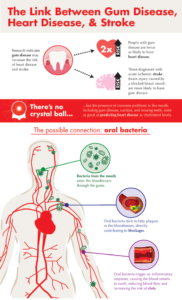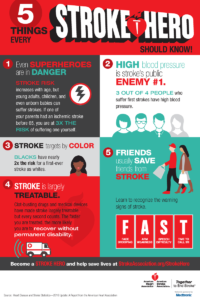Strokes and gum disease have a lot in common, more than most people think. Both diseases have serious implications for patients. Both diseases are prevalent in the U.S.; gum disease affects over 64 million Americans, and on average, every four minutes one American dies from a stroke. Both conditions are associated with vascular inflammation.
The most important similarity between the two conditions might be this inflammation. In fact, research suggests that the inflammation associated with strokes and gum disease is connected. According to perio.org, one study showed that patients that suffered an acute cerebrovascular ischemia had a higher likelihood of also having an oral infection when they compared the numbers to a control group.
Other research shows periodontal inflammation has connections to many systemic diseases, including breast cancer, diabetes, and heart disease, also as part of a link through the inflammation. It is important to note that no study has discovered a causal relationship between gum disease and these other systemic conditions.
Systemic diseases affect the whole body and lower its ability to fight off infection and inflammation. The ADA explains the relationship as related but not causal. For example, a smoker could have a higher risk than nonsmokers for developing both gum and heart disease, but the cause of both conditions is the smoking.
Facts About Gum Disease
Gum disease, also called periodontal disease, is an inflammatory disease that affects the hard and soft tissues supporting the teeth. Many times, poor oral hygiene causes this infection of the gums. It starts as gingivitis, which is the mildest form of periodontal disease. It causes gums to turn red, to swell, and bleed. If left untreated, gingivitis will worsen to periodontitis. When the bacteria associated with periodontitis make its way below the gum line, it sends toxins into the blood stream. These toxins create inflammation in the body that can destroy tissue and bone in the mouth, causing gums to separate from the teeth. This separation allows bacteria to infect the gums, and, over time, can lead to tooth loss.
Read more about what the American Academy of Periodontology says about periodontal disease.
This amusing video from the American Academy of Periodontology has great tips about the prevention of gum disease.
Facts About Strokes
Strokes occur in the brain when a blood clot prevents oxygen from getting to the brain or when a blood vessel in the brain bursts. Anyone can have a stroke at any age, but the risk for stroke increases due to age, sex, and ethnicity. Some risks attribute to poor lifestyle choices, such as smoking, excessive alcohol consumption and lack of exercise. Other health conditions, like heart disease, high blood pressure, high cholesterol or diabetes can also contribute to your risk factor for a stroke.
Many factors associated with stroke risk are not preventable. However, taking action quickly when you suspect you are having a stroke can help prevent permanent damage.
This video from UHN Toronto shows a stroke as it happens.
May is American Stroke Month. Strokeassociation.org prepared this “5 Things to Know About Stroke” flyer to help spread awareness about the risk factors for stroke and how to react when you suspect you or someone you know is having a stroke.
Download the CDC’s fact sheet about strokes.
Facts about Strokes and Gum Disease
In 2004, researchers in Germany identified an increased risk for an ischemic stroke for patients also suffering severe periodontitis, especially for men and patients under the age of 60.
What is an ischemic stroke? An ischemic stroke happens when a blood vessel delivering blood to the brain is blocked, and prevents oxygen from getting to the brain. According to the CDC, 85% of strokes are ischemic.
Another study in 2012 from the Attikon University Hospital in Athens, Greece confirmed that patients with periodontitis are associated with a higher risk of stroke. However, the authors of the study cautioned that further research is needed on this topic “because of the heterogeneity of the study and the differences in periodontitis definition.”
Moderate to severe periodontal disease is treatable. For many years, traditional surgery with a scalpel and sutures was the only option. Unfortunately, the treatment is painful and requires a long recovery time. Recently, a laser treatment option was approved by the FDA (Food and Drug Administration). The LANAP® protocol as a laser surgery option facilitates a less painful, more successful treatment with a shorter recovery time. For more information on the FDA approved LANAP® protocol, visit www.lanap.com.
Stroke and gum disease have a lot of things in common, especially the inflammation associated with both. With so many Americans affected by both conditions, it is important to recognize that the two might have connections. By knowing the facts about both diseases, you and your medical and dental professionals can make better decisions about how to reduce your risk of both diseases.
Sources:
Peke, P. I., et al. “Prevalence of Periodontis in Adults in the United States: 2009 2010.” Journal of Dental Research 91.10 (2012): 914-20. Prevalence of Periodontitis in Adults in the United States: 2009 and 2010. Sage Journals, 30 Aug. 2012. Web. 22 Apr. 2016.
“Stroke Facts.” www.cdc.gov. Web. 4 May 2016. <http://www.cdc.gov/stroke/facts.htm> References: Mozaffarian D, Benjamin EJ, Go AS, et al. Heart disease and stroke statistics—2015 update: a report from the American Heart Association. Circulation. 2015 ;e29-322.
“Gum Disease and Heart Disease.” www.perio.org. Web. 4 May 2016. <https://www.perio.org/consumer/heart_disease>
“Periodontal Disease and Systemic Health.” www.perio.org. Web. 22 April 2016. <https://www.perio.org/consumer/other-diseases>
“Oral Health Topics.” www.ada.org. Web. 22 April 2016. <http://www.ada.org/en/member-center/oral-health-topics/oral-systemic-health>
“Types of Gum Disease.” www.perio.org. Web. 4 May 2016. <https://www.perio.org/consumer/types-gum-disease.html>
“About Stroke.” www.cdc.gov. Web. 4 May 2016. <http://www.cdc.gov/stroke/about.htm>
“Risk factors.” www.cdc.gov. Web. 4 May 2016. <http://www.cdc.gov/stroke/risk_factors.htm>
Grau, MD, Armin J.; Becher, PhD, Heiko; Christoph M. Ziegler, M.D., et al. “Periodontal Disease as a Risk Factor for Ischemic Stroke.” Stroke (2004) 35: 496-501. Web Stroke.ahajournals.org. <http://stroke.ahajournals.org/content/35/2/496.full>
“Types of Stroke.” www.cdc.org. Web. 4 May 2016. <http://www.cdc.gov/stroke/types_of_stroke.htm>. Article refers to: Go AS, Mozaffarian D, Roger VL, Benjamin EJ, Berry JD, Borden WB, et al. Heart disease and stroke statistics—2013 update: a report from the American Heart Association. Circulation. 2012:e2–241.
Sfyroeras, GS; Roussas, N., Saleptsis, VG, et al. “Association between periodontal disease and stroke.” J Vasc Surg. 2012 Apr;55(4):1178-84. doi: 10.1016/j.jvs.2011.10.008. Epub 2012 Jan 14. Web. www.ncbi.nlm.nih.gov. <http://www.ncbi.nlm.nih.gov/pubmed/22244863>




Leave a Reply